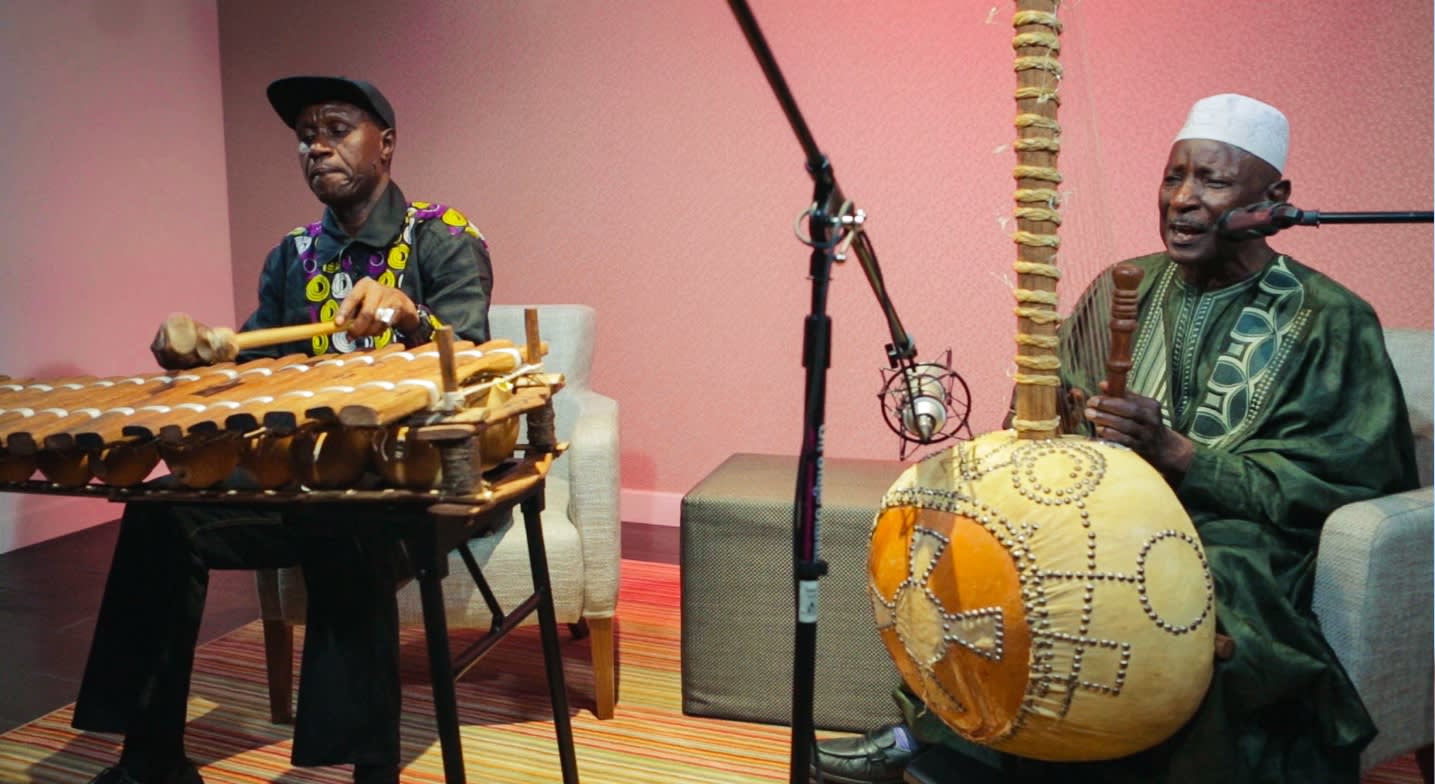Before we get to our interview, let me tell you the story about how I got to meet Alhaji Papa Susso, a world-famous griot, or West African storyteller. While interning for Audible Range, we ran stories about traditional Irish storytelling and Greek oral tradition. This got me curious about other storytelling traditions. A lot of my friends are of African descent, and I’ve always wondered about the different cultures of their heritage. I see people walking around wearing African-inspired clothing like dashikis, or listening to their daily dose of Beyoncé’s Lemonade, which was inspired by African style and culture. I had heard about the West African storytelling tradition of griot in school, and I wanted to dive deeper and investigate, to hear it from the source.
My research led me to Dr. Tom Hale, a professor at Penn State University, and author of the book Griot and Griottes: Masters of Words and Music. After a fascinating interview, Dr. Hale introduced me to his longtime friend Alhaji Papa Susso, who generously agreed to visit Audible headquarters for an interview and performance.
Dr. Hale told me that griots have sustained power in West African culture, despite enduring many trials and tribulations throughout their history. Griots have been around for centuries, and, through music and storytelling, have passed on the true history and culture of West Africa by continually reminding communities of their heritage, despite an ever-changing world. As technology spreads throughout Africa, women gain power and influence in West African society, and griots continue to travel around the world to perform, the role of griots will inevitably change with the times, as it always has, but they will likely remain an important part of West African culture, as they have for ages.
As Papa Susso proudly proclaimed at the end of our interview: “I’m a griot! I will be a griot until I die!”
Read on for highlights from from our interview, and watch him perform a traditional griot song on his kora, which his father made for him in 1941, accompanied by balafon player Wuye Jassey.
N’Kaela Webster: What is a griot?
Papa Susso: Griots are traditional musicians, oral historians, poets, counselors, and entertainers. They were attached to the royal courts to recount the tribal history of African people and also compose commemorative songs and perform in important tribal ceremonies like weddings, or the naming of a child, or ritual circumcision. So the duty of the griot in African society is very important, because they tell the people who they are, where they came from, and where they’re supposed to head to. The work of the griot is recounting the tribal history of our people. The griot deals with the reality [of] things that happened within the society in the past. Storytellers deal with mythology.

Papa Susso had lunch with Audible’s high school interns, and taught about the history of the Griot in his native country Gambia.
NW: Previously you talked about how the old traditions are now unisex, so is there still any difference between female and male griots?
PS: Females, in the history of the griots, have a role to play by singing and dancing around the music. So the singing that the female griots do, this is the epic narrative. They recite history of clans or tribes, people, different places, different things happening within the society. Traditionally, in Africa, to work as griot or to even become a griot means you have to be born into the family of griot.
NW: So is it traditional for people to not follow the griot tradition?
PS: The fear my mother used to have was [that] this is a very strong tradition that our people always want to maintain. But what about if this boy goes to school, gets a good education, gets a good job … he might not want to do this. And that means his children cannot get it. And if my children don’t get it, that mean it’s gone, it’s finished. My father said to me, good luck to you with the office, but my advice to you is, don’t throw this instrument away, you should always keep this instrument to yourself. I think my father tried very hard by giving me two professions. Now that I know the secret in the office, maybe I should go back to the griot tradition and see what I can get from that, too.

Papa Susso performs a story at an Audible company happy hour.
NW: I read that the kora (a griot’s traditional musical instrument) is a famous tradition in your family, so can you speak more about it?
PS: I started to learn how to play this instrument when I was five years old. The songs that the griots play with the instrument altogether is 32 songs. These are very important songs that we want to continue to keep, because they have the history of our people.
First of all, the kora is a very old instrument. It was invented in the 13th century.

Papa Susso shows the author, Audible Intern N’Kaela Webster, a few notes on the kora.
[The front of the instrument] is cowhide. [The neck, bridge, and hand-posts] are rosewood, and [the body] is calabash. Calabash is something that we grow in Africa, it’s very big. In fact, [we use] just half of it [for a kora]. We’ll grow this on the ground, and this is half of it if you cut in the center, take the seeds out, and then cover it with a cowhide, then you start to make the instrument. This particular one, this is a very old instrument, because this one was made by my father in 1941, when I was not even born yet. Passed down from father to son, from generation to generation. It’s a very famous and very important instrument in my part of Africa.
N’Kaela Webster joins Audible Range as part of Audible’s high school internship program with Newark’s North Star Academy, where she is currently a senior. She’ll be attending college in the fall.
To learn more about griot, we highly recommend Dr. Hale’s definitive book on griot, Griot and Griottes: Masters of Words and Music, which provided a wealth of background information on this story.




